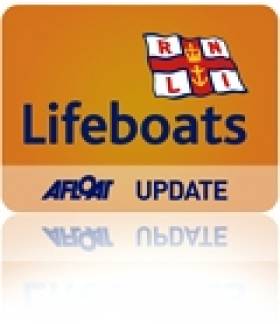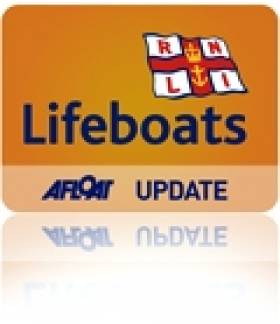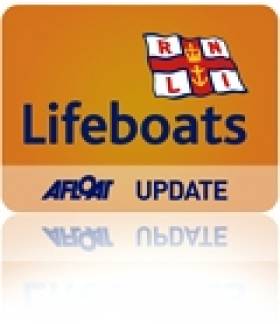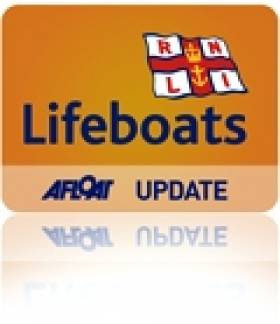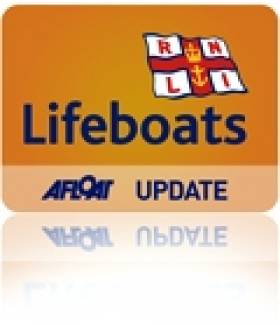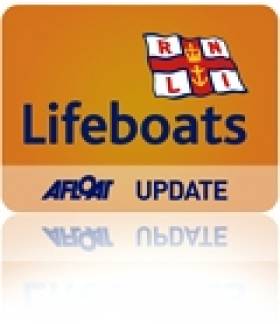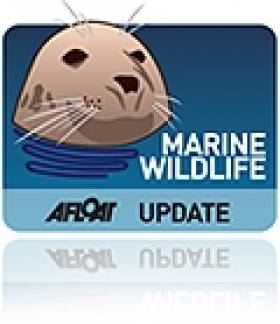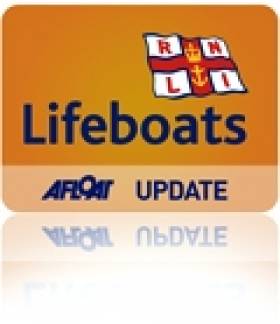Displaying items by tag: Lifeboats
Skerries Lifeboat Saves Man From Drowning
#RNLI - Skerries RNLI saved a man from drowning yesterday afternoon (Wednesday 22 April) as they responded to an emergency call on their pagers.
Volunteer crew member Stephen Crowley was giving one of his fellow volunteers, helm David Knight, a lift ashore from his own boat shortly after 5pm when the pagers were set off.
As they made their way to the slipway at the back of the harbour to get to the lifeboat station, they encountered a man in the water who had become separated from his personal watercraft and was struggling to stay afloat.
They managed to get a rope around the man and help him onto the side of their boat and began bringing the man to shore, where they were joined by two more volunteers, helm Philip Ferguson and crew member Emma Wilson, who were already fully suited up and preparing the boat for launch when they saw the situation unfolding from the lifeboat station.
The man was helped ashore and was assessed for any first aid requirement.
Speaking after the callout, volunteer lifeboat press officer Gerry Canning said: "Fortunately our volunteers were on hand almost instantly. It is important to remember that whatever your activity, wearing a well-fitted and suitable lifejacket or buoyancy aid could save your life."
Busy Sunday Night For Larne Lifeboats
#RNLI - The volunteer lifeboat crew with Larne RNLI had a busy Sunday evening (19 April) when both the all-weather and inshore lifeboats were tasked to two separate incidents within minutes of each other.
The inshore lifeboat was launched to aid a 20-foot rowing boat with two people onboard, which was having difficulty making it to land in Ballygally Bay when it was hit by strong tides.
Meanwhile, the all-weather lifeboat was sent to search Brown’s Bay after reports were received of two canoes washed ashore with nobody on them.
The inshore lifeboat crew were quickly stood down when the two people on the rowing boat managed to make it to shore safely. The crew then immediately proceeded to Brown’s Bay where they joined their all-weather lifeboat crew colleagues in the search for the suspected two missing canoeists.
Both lifeboat crews were stood down around 45 minutes later following a call to Belfast Coastguard by a woman who said the two boys who had been on the canoes had capsized and managed to make it to shore. They were unable to recover their canoes and so the crafts were left on scene. The boys had made it home safely.
Commenting on the callouts, Larne RNLI crew member Pamela Dorman said: "Thankfully both these callouts had a successful outcome but with conditions being choppy with a Force 4m you can never take a chance.
"These types of callouts are always taken seriously by us and treated as missing persons until further information can be obtained. We would like to thank the woman who phoned the coastguard as we were able to recover the craft so that other alerts would not be issued.
"We would always advise people who see something at sea that worries them, to raise the alarm. You never know when a life could depend on it."
'Duck Race' For Helvick Head RNLI Hailed A Success
#RNLI - The Duck Race in aid of the Helvick Head RNLI lifeboat station on Saturday 11 April 11th was a "spectacular success", according to race co-ordinator RoseAnn Foley.
As part of the Cois Cé celebrations during West Waterford Festival of Food, the 600 little yellow ducks entered the water from Devonshire Bridge in Dungarvan at 1.15pm with a lively commentary from Jenny Beresford and Sean Breathnach as they floated down Davitt’s Quay.
First prize in the Duck Race went to RNLI crew Liam Harty. Second was a photo finish between Séamus Kiersey from Ardmore and Tomás de Faoite ón Rinn, while third went to Tom Considine from Dungarvan and fourth went to Catherine Downey also from An Rinn.
Later, all the ducks were collected from the mud and were washed and put into storage until their next race.
And they weren't the only attraction on the day, with a free lifejacket clinic and sea safety check conducted by Austin Flynn also proving popular.
"We are very grateful to the public, Dungarvan Harbour Sailing Club, the kayakers, SGC and all our sponsors, West Waterford Festival of Food and the media for their enormous support," said Foley.
Bundoran Lifeboat Rescues Teen After Jet Ski Capsize
#RNLI - Bundoran RNLI rescued a teenager who fell from a capsized jet ski on Thursday afternoon (9 April).
The volunteer crew was requested to launch their inshore lifeboat by Malin Head Coast Guard at 1.24pm following a report that a jet ski had capsized a short distance from Bundoran Pier.
The lifeboat, helmed by Daimon Fergus and with crew members James Cassidy and Elliot Kearns on board, launched and made its way to the scene just a couple of hundred yards from the shore. Weather conditions at the time were described as good with the sun shining and the sea flat calm.
On arrival, the crew observed two males, one of whom had managed to get back on to the jet ski and a second who was still in the water.
The lifeboat crew pulled the teenager from the water and brought him back to shore where he was treated for hypothermia and the effects of having swallowed some sea water. He was subsequently transferred to Sligo General Hospital via ambulance as a precautionary measure.
"Thankfully, the lifeboat crew were able to assist this afternoon and bring this young man to safety," said Bundoran RNLI lifeboat operations manager Tony McGowan after the callout.
McGowan also encouraged anyone taking to the water "to enjoy themselves but be mindful that while the sun is shining and the weather is warm, sea temperatures are still very cold and it is important to dress appropriately bearing that in mind."
Bundoran's lifeboat crew were tasked again on Friday night (10 April) to reports of a red flare spotted over Rossnowlagh.
Following a call to Malin Head Coast Guard, the crew were paged just after 9pm and launched a short time later under cover of darkness, arriving at Rossnowlagh just before 9.30pm to commence a search of the area near Smugglers Creek. They were also joined by the Sligo-based Irish Coast Guard helicopter.
The search continued for approximately one hour before both crews were stood down and returned to base having found nothing.
Speaking on their return to the lifeboat station, volunteer helm Elliot Kearns said: "We would class this a false alarm with good intent and the member of the public who made the call was exactly right to call the coastguard. We would always rather be called to something that somebody was unsure about rather than a life be lost."
However, Kearns also urged anyone setting off Chinese lantern or lighting fires near the coast "to call the coastguard in advance to advise them. Of course if you see anyone in trouble at the coast please dial 999 or 112 immediately."
The callout was the third in a week for the Bundoran station, beginning with the rescue of a surfer in difficulty off Tullan Strand on Monday 6 April.
#RNLI - Arranmore RNLI saved two fishermen on Wednesday afternoon (8 April) after their 10m boat capsized off the Donegal coast.
A member of the public who was watching the fishing vessel from the shoreline raised the alarm at 2.50pm after he saw the boat capsize two miles south of Arranmore.
Arranmore RNLI’s boarding boat, which was already at sea with coxswain Anton Kavanagh and mechanic Philip McCauley on board, made its way to the scene.
Weather conditions at the time were described as blowing a gentle Force 2 to 3 wind but there was a heavy ground swell of three to four metres.
During their short passage, the volunteer lifeboat crew spotted and followed a track of fuel, and once on scene observed the wreckage of the stricken vessel. They then observed the two fishermen in the water approximately 300 yards from where the boat had capsized.
Both men were very cold when they were pulled from the sea and brought onboard Arranmore RNLI’s boat.
They were brought to Aphort Harbour, where they were made comfortable before being airlifted by the Irish Coast Guard’s Rescue 118 helicopter from Sligo and transferred to Letterkenny General Hospital.
Speaking following the callout, Anton Kavanagh said: "Both men are very lucky to be alive today and full credit must go to the member of the public who saw the boat capsize and raised the alarm, because the fishermen were not due back to shore for a couple of hours.
"We were delighted to be able to help and are glad that both men are safe and well."
#RNLI - Jack Lowe has loved the RNLI since he was a little boy. He became a member of Storm Force, the charity’s club for children, at the age of eight – about the same time he picked up his first camera.
Now, he’s bringing his two passions together in a unique undertaking: The Lifeboat Station Project.
Jack plans to visit all 237 RNLI lifeboat stations in Britain and Ireland, photographing the view from each station along with the crew and coxswain/senior helm using wet plate collodion, a Victorian process that allows him to record stunning images on glass.
The ambitious project is likely to take three to five years to complete. Jack, who lives in Newcastle upon Tyne, travels in 'Neena' — a decommissioned NHS ambulance purchased on eBay and converted into a mobile darkroom.
Grandson of Dad’s Army actor Arthur Lowe, also an avid RNLI supporter, Jack explains: "My early childhood was spent on a Victorian schooner in Ramsgate harbour and on the Thames. My Dad is an experienced seafarer and introduced me to the wonders of lifeboats – these wonderful, powerful pieces of kit designed for heroic, lifesaving missions on stormy seas.
"From an early age, I knew that I wanted to be either a photographer or a lifeboat crew member when I grew up. Now I’m following my heart and uniting the two dreams.
"I’m using a photographic technique developed in the 1850s, around the time that the RNLI was incorporated under Royal Charter. The photographs are made directly onto glass plates known as 'ambrotypes'." Jack has already documented all 15 stations on the East Anglian coast.
“The project now enjoys an incredible extra dimension as everyone is so involved and engaged with it," he says. "The coxswain and crew can step into the ambulance and watch a portrait of themselves developing. They are entranced, often rendered speechless and sometimes moved to tears!"
Jack began drawing up plans for the project over two years ago. He says he has always had an interest in the history of photography.
"The word photography means drawing with light and that is how I think about it still. I adore photography in this very raw, basic form — light falling on chemicals. It really is magical – the final image is always a surprise, even to me."
He adds: "There’s a small global community of people interested in using these old techniques. Everyone works in their own way – and you’re always learning as you go along.
"The chemicals are the original formulae from the 1800s. It took me a long time to figure out the logistics of transporting and storing glass plates. I have a box made for each station that holds 10 sheets of 10x12” glass. Then when I get them back to Newcastle I scan them, varnish them and then place them into storage."
It’s a real labour of love, even for a dedicated RNLI fan, but Jack always looks forward to his next station visit.
Follow Jack Lowe’s RNLI photographic mission on Facebook, on Twitter or on the project’s dedicated site.
Bundoran Lifeboat Launches To Surfer In Difficulty
#Lifeboats - Yesterday evening (Monday 6 April), the volunteer crew of Bundoran RNLI were requested by the Irish Coast Guard at Malin Head to launch to a surfer in difficulty.
Shortly after 8pm, a passer-by noticed a female surfer in difficulty off Tullan Strand in Bundoran and immediately dialled 999.
Moments later the lifeboat crew were paged and within four minutes the Atlantic 85 lifeboat was launched from the pier, arriving on scene in under three minutes.
The crew brought the surfer and her surfboard on to the lifeboat and performed a quick medical check finding she was shaken but uninjured. The crew then returned to the station.
Speaking after their return, lifeboat helm Brian Gillespie said: "We are thankful to the member of the public who did the right thing by calling the coastguard.
"Darkness was beginning to fall and had it been any later the situation may have turned more dangerous. Thankfully the surfer is OK.
"As the weather is getting better, we want people to enjoy themselves but we would urge water users to exercise common sense and heed basic water safety principles.”
Kilkeel Lifeboat Manager Roy Teggarty Retires
#RNLI - Roy Teggarty has retired as lifeboat operations manager at Kilkeel RNLI in Co Down.
At a social evening in the local British Legion on Friday 27 March, Teggarty was pleased to greet fellow Kilkeel RNLI colleagues as well as staff and volunteers from neighbouring stations.
Coming from a fishing and nautical background, Teggarty was an obvious choice when in 1994 the lifeboat crew in Kilkeel were looking for a deputy landing authority (DLA).
He brought hard work, dedication and excellent organisational skills to the station ensuring, with the help of others in management, that the building and the equipment were always up to the required tasks.
In the year 2000, all his experiences were recognised when he was appointed as lifeboat operations manager (LOM). Over the years he has ensured that the crew have maintained the high professional standards they have always set for themselves.
Commenting on his years of service, Teggarty stated that the majority of callouts have been routine but, as always with this role, some have been very very dark tragic days.
"I have thoroughly enjoyed my time as DLA and LOM of Kilkeel RNLI, working with a dedicated team of volunteers, not only on the operational side but also with the excellent team of fundraisers," he said.
"Although I am standing down as LOM, I am sure that the station will continue to provide an excellent and professional service under the leadership of their new LOM John Fisher. I wish them all the best for the future in continuing to save lives at sea."
Thanking him for his many years of service, Leslie Campbell, Kilkeel RNLI volunteer lifeboat press officer, said: "The crew and fundraisers would like to wish Roy a long and rewarding retirement free from early morning alarm calls and thanks for your dedication, loyalty and years of faithful service."
Akrlow Seal 'Sammy' Rescued Near Rocky Shoreline
#MarineWildlife - On Friday morning (3 April) Arklow RNLI was made aware of a seal apparently caught in fishing gear close to the Arklow Harbour entrance.
Two of Arklow RNLI’s team went to the area to ascertain if it was feasible to launch the lifeboat to rescue the weary marine mammal, identified locally as Sammy - the subject of a previous rescue some 18 months ago when still a pup.
Due to conditions in the area and due to the proximity of the shoreline and an ebbing tide at the location, it was decided it was inadvisable to launch the Ger Tigchelaar.
Because of the trapped animal's proximity to the shore, and to eliminate the further risk of any members of the public entering the water to save the seal, it was decided instead to try to rescue the animal from a smaller rescue craft.
Two of Arklow RNLI’s volunteers, station mechanic Michael Fitzgerald, and Brian Heaney, went to sea to the aid of the tiring animal.
After hauling in the fishing gear, the exhausted and stressed seal was moved to an area where it could make for the shore to rest and was then cut loose from the fishing gear.
The seal had a short break on the lower rocks of the shoreline before making for open water.
Speaking following the incident, Fitzgerald said: “Luckily we were able to get to the seal in time to save it.
"When members of the pubic come across injured or stressed animals like this trapped in fishing gear or injured, they should inform the authorities immediately, they should never enter the water to try to save the animal.
"They should always leave this to persons who are experienced and have the right equipment to carry out the rescue safely. Always respect the water.”
#RNLI - The RNLI’s first permanent inland lifeboat station is now complete and fully operational on Upper Lough Erne in Co Fermanagh.
After been housed in temporary accommodation for 13 years, Enniskilllen RNLI volunteers were handed the keys to their new building in Carrybridge this week.
The modern purpose-built lifeboat station is located close to the lough to allow for an efficient launch of its inshore lifeboat and rescue water craft.
The station, which also houses the associated launching tractor and equipment, full crew changing facilities, a workshop, office and training room, will be officially opened later this year.
First announced nearly two years ago, the build took little over a year to complete was carried out by the Omagh based Woodvale Construction Company and handed over to the RNLI last Wednesday 25 March.
The building is designed with a heating system which allows the heat to be drawn from the ground and produced inside, keeping the temperature at an ambient 15 degrees Celsius. The excess is used to heat the water for showering, washing-up and cleaning the vessels. Solar panels on the roof will also generate electricity for the station's needs.
In order to facilitate the project, the local community helped the charity raise £60,000 towards the cost, which will now help the RNLI’s 40 volunteers based at Enniskillen to continue to save lives on Lough Erne.
In 2001, Enniskillen became home to the RNLI’s first inland lifeboat station based on Lower Lough Erne. Due to the overall size and complexity of the lough and its high leisure usage, the decision was taken by the RNLI in 2002 to base a second lifeboat on the Upper Lough at Carrybridge that would work in conjunction with the original lifeboat station on the Lower Lough at Killadeas.
With two bases, two inshore lifeboats and two rescue water craft, the station has since proved to be one of the busiest in Ireland.
Last year alone, Enniskillen RNLI launched 59 times, bringing 57 people to safety. Some 32 of those services were carried out in the dark while the crew spent 262 service hours on the water.
Speaking following the handover of the new building, RNLI divisional technical manager Derek Potter said he was delighted that the station was now complete.
"From the outset, we wanted to build a modern station with full crew facilities with areas for the crew to change and train and space to keep their lifeboat and rescue water craft and lifesaving kit safe," he said.
"We now have those facilities and are very happy to be in a position to take over the new lifeboat station and are delighted with both the design and quality of the building."
Enniskillen lifeboat operations manager Davey Robinson added that the new station was what the crew deserved.
"The new station is a testament to the RNLI’s commitment and dedication to the community here locally and a credit to our crews efforts in continuing to bring people to safety on Lough Erne," he said.
"Our volunteers had an opportunity to be shown around their new station this week and they are overwhelmed with the structure and facilities that they now have when they come together for callouts and training.
"We would like to thank everyone who has helped us to get to this stage including all those who donated, organised or participated in any fundraising activity."





























